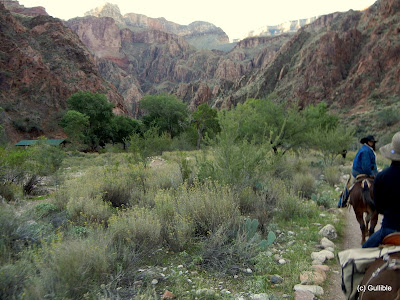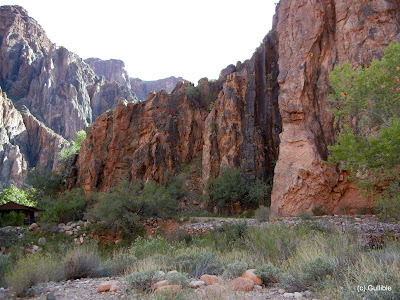(Reminder: Clicking on a photo should enlarge it. On my computer, clicking on it again, enlarges it to full screen.)
My tummy was full of New York steak, baked potato, salad and veggies, topped off with chocolate cake. My body was very happy after a hot shower that washed away the remaining aches.
Then I made an awful discovery. In an effort to take only the essentials for an overnight stay at Phantom Ranch in the bottom of the Grand Canyon, I had neglected to bring anything to read. I was ready for bed and had no desire to get dressed and go to the canteen to search for reading material. Besides, the canteen was full of hikers chowing down on stew.
So I crawled in bed at 6:30, wrote some unreadable nonsense in my journal, and went to sleep at 8:30. I heard the canteen bell ringing frantically shortly after I went to sleep. I got up long enough to look out the windows for anything on fire, then went back to bed.
My tiny travel alarm went off at zero dark thirty. I had to have my little bag of belongings down by the corral before 6:30, and myself at the canteen for breakfast precisely at 6:30.There was barely enough light enough to see without a flashlight (I was at the bottom of a canyon, after all) when I delivered my luggage to the stone corral. Down at the main corral the wrangler was saddling the mules, packing snacks in the saddle bags. I walked back to the canteen and waited for the doors to open.
Despite a horrendous case of bed head, I presented myself at the Phantom Ranch canteen.
As we waited, I heard a man describing a rescue on the trail the night before. The hiker told of coming across a woman hiker who was disoriented, perhaps from dehydration. Her companion was with her, so the hiker said he’d go ahead for help.
By this time it was dark, and the hiker somehow found his way along the trail, completely missing the hiker’s bridge. Thus, he felt his way along the scary part of the trail to the Black Bridge, extending his walk by a mile and a half.
I asked him if there had been any ambient light and he said there hadn’t. “It was pitch black,” he said. I was dumbfounded that he had missed the Silver Bridge. (Go to this site and look at the first two photos of the approach to the Silver Bridge--the rock wall side--to see how difficult it would be to miss this bridge. It MUST have been dark: http://www.bridgemeister.com/pic.php?pid=1941)
The ringing bell summoned the Park Rangers and the woman was brought in without incident.
 After scrambled eggs, bacon, sausage, and pancakes, we six riders presented ourselves at the appointed place in the cool morning air. Wrangler Tina looked us over. No one appeared too bowlegged or in obvious pain. The morning was cool. Not freezing cold as it had been at the South Rim. Cool at 43 degrees. Perfect.
After scrambled eggs, bacon, sausage, and pancakes, we six riders presented ourselves at the appointed place in the cool morning air. Wrangler Tina looked us over. No one appeared too bowlegged or in obvious pain. The morning was cool. Not freezing cold as it had been at the South Rim. Cool at 43 degrees. Perfect.

 With TC and the US Mail pouches. Note the front of the stirrups are enclosed with leather. That's not my foot below the leather, but a rock behind us.
With TC and the US Mail pouches. Note the front of the stirrups are enclosed with leather. That's not my foot below the leather, but a rock behind us. Shaking Lady had promised in an oath at the beginning of this ride to jump in the Colorado River and rescue the mail should it somehow land in said river. I didn’t have to take that oath because I already have carrier credentials.. Good thing, too, because I can’t swim.
“Neither rain nor pain nor saddle sores shall stay us couriers from the swift completion of our appointed rounds,” I said to myself. I mentioned this to TC while the other riders mounted up. TC snorted.
Not too sure about “swift completion” when we’re talking about mules climbing back up to the Rim. It took slightly more than five hours going down to the ranch; it would take about six and a half going up.
Wrangler Tina checking on us as we rode out of Dodge.
The sun was just kissing the cliffs and escarpments at the top of the Canyon as we rode out of Dodge.


TC didn’t exactly renege on our agreement about scraping, but he started reaching back with his head and scratching his face on my foot, or rather, the stirrup that held my foot.
 When we reached our break place at Indian Gardens, six mule dear were browsing there. I didn't have my camera ready and missed a great shot of a fawn looking over his mother's back, wondering if he should run or stay with mom.
When we reached our break place at Indian Gardens, six mule dear were browsing there. I didn't have my camera ready and missed a great shot of a fawn looking over his mother's back, wondering if he should run or stay with mom.And then TC did it—he pushed the stirrup outward with his nose, giving my knee a nice twist. I thought he’d done serious damage to the knee for about an hour, and sniveled to myself. Then I gave up. Looking in the saddle bag, I discovered I had my own stuff (they pack it randomly, so you don’t necessarily carry your own gear). After a bit of self-medication, I didn’t hurt anywhere anymore, forever and ever, amen.

A hairpin turn on Bright Angel trail.
We made lots of stops on the way up, especially in the steepest portions of the trail. Close to the top, I noticed ice beside the trail. Must have been a cold trip for the riders starting that morning As for me, I had been comfortable the entire ride up.
Eventually, we topped out. I didn’t even need any help dismounting. I felt great.
I said goodbye to my mule. "TC, " I said as I patted him. "Thanks for a great trip. Sorry about not being an experienced rider, but, heck, it's better than hauling borax, huh?" I thanked Tina, slipping a tip into her hand, and headed for my room at the Bright Angel Lodge, stopping by the soda fountain first for a big lemonade.
Please Read--Important
Self-medicating works, too. And about that? It's a prescription pain killer coveted by Dr. House on TV. I've had it three years, and only two are missing from the original amount.
Saddle sores? Hmmm. Yeah, but they go away in a few days, and mine didn’t blister after all. I should have done what I did when I rode a horse ten miles across Haleakala Crater on Maui, and ten miles back. I wore padded bike shorts over my jeans. Looked silly, but it worked.

A mule train ascending Bright Angel the next day.
TC trying to scrape me off? Totally accidental. TC was a very round mule and thus my short legs stuck out farther than he realized. As Wrangler Tina said, "It's like trying to saddle a barrel," as she made some comment about TC being overweight.
TC chose his part of the path carefully—he was no dumb mule, but a canny, experienced Grand Canyon rider-certified mule. If that part of the path was too close to the rock walls, it was my job to watch out for that. The thing with his face twisting my knee—that was TC’s bad, but after the self-medication wore off, my knee didn’t hurt.

This shows the lower portion of Bright Angel Trail, after descending Jacob's Ladder (see next photo). The lush green strip is Indian Gardens. From there, the trail descends the green gully (not the light colored trail seen in the photo, but to the right of it) to Jesus Corner, the Devil's Corkscrew, and The Furnace to the Colorado River. It takes a right turn along the river to the bridges.
Danger? Of course. Hiking the Canyon trails is dangerous on your own two feet, but the mules are chosen carefully and well-trained. Mules are known for being sure-footed. In more than a hundred years of carrying people into the canyon, the mules have never lost a rider. That’s estimated to be more than 600,000 people.

Don’t know how to ride? Listen, this is bonehead mule riding. The mules know everything. All you have to do is sit on top, have fun, and take lots of pictures. The reins are tied to the correct length.
Would I recommend this trip? Absolutely. It’s a terrific adventure and a great way to see the Canyon and Phantom Ranch. These trips often sell out a year in advance.

Part of the upper portion of Bright Angel Trail, descending from the South Rim. The switchbacks are called Jacob's Ladder.
How would I rate it? A ten, no question. Among one of my finest adventures.










































